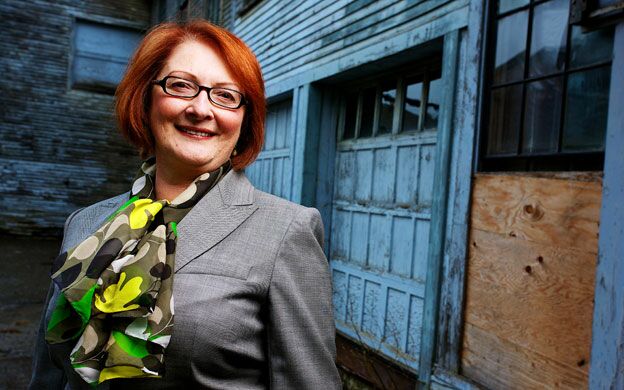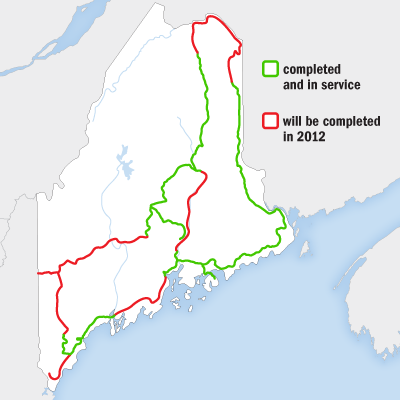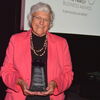A rural county pins its economic hopes on a new fiber-optic Internet spine
Prior to 2011, Nicole Snow had moved in and out of 10 communities in a five-year period to keep up with her husband Michael's engineering job. During that time, she adapted to being on the move by building an equally mobile Internet-based yarn company.
Not just any yarn company, but Darn Good Yarn, a company with a social mission to up-cycle scraps of silk otherwise destined for landfills while offering gainful employment to women and men in India.
So when Michael proposed buying a house in Sebec last year to be closer to his parents, she didn't mind moving to the town of about 630 people, about 10 miles northeast of Dover-Foxcroft.
“The Internet is a crazy-wide place,” says Snow.
But she quickly found that Internet connections in Piscataquis, the most rural county in the most rural state in the nation, can be spotty at best. While much of the county is still served by dial-up connections, Snow found a faster DSL connection. But even that wasn't enough to prevent her business from suffering.
“I did more [business] when I had a better [Internet] connection,” she says. “I didn't think it would be this bad. I thought it would be kind of bad.”
Snow, along with economic development officials in Piscataquis County, is hoping that will change soon when the Three Ring Binder Project is complete, placing a high-speed, fiber-optic spine through some of Maine's most rural communities.
The Piscataquis County Economic Development Council hopes the new high-speed cable will increase the number of e-commuters and at-home entrepreneurs — an economic development strategy that would allow the county to increase its population and grow its business base while preserving its more important asset: its tranquil, natural environment.
‘Curse fest’
Snow admits she didn't realize the limitations of Internet connectivity before she moved in 2011. But she takes it all in stride, since she constantly deals with spinners, exporters and importers in a country where people often have to travel for two hours to get an Internet connection.
“I deal with people in India with way worse conditions than me,” she says.
Even so, limited connections here have slowed the growth of her business, which had been doubling every year since it was started in 2008. It has also made it more difficult to train spinners, who undertake a labor-intensive process of collecting silk scraps from textile mills and turning them into yarn.
Snow says it takes a specific technique to produce a fine, high-quality yarn from silk scraps. She teaches her 150 to 300 spinners through Skype, a web-based video telephone service that allows her to demonstrate her techniques visually. But those Skype sessions, which generally need to last 15 minutes, require high-speed Internet connections; in Sebec, the sessions are constantly interrupted or dropped altogether.
“I can't really have more than a two- or three-minute Skype session,” she says. “It's pretty bad. I came from places that had cable for Internet and I never had a problem with it.”
Snow tries to deal with the problem by uploading video tutorials on YouTube, but the spotty connection slows down the process. The tutorials are also popular with the public, she says, often leading to 15 or so likes on her Facebook page for every video. Now, Snow can produce and upload one only video a week, rather than five a week on high-speed Internet.
It can also take three minutes to upload a 3-megabyte photo, she says, which creates a challenge when trying to connect her customers to her spinners in India by using social media — an increasingly important aspect of her business.
“Sometimes I have a little curse fest at my desk,” she says jokingly. “But I deal with people with rolling blackouts, so I can't complain.”
Laying a spine
The Three Ring Binder Project grew out of the 2009 American Recovery and Reinvestment Act and aims to improve broadband Internet service in rural parts of the country. In Maine, that project will create a 1,100-mile fiber-optic spine through the eastern half of the state, making broadband more accessible to 110,000 households and 600 community anchor institutions.
Maine Fiber Co. was formed to oversee the construction, leasing and operation of the project, which received a $27.4 million grant and $7 million in private financing. As of April 26, MFC had put down 609 miles of cable and projected a June 30 completion date, according to its website.
But the project lays only a spine throughout rural counties like Piscataquis. It will be up to local Internet service providers, or ISPs, to connect outlying communities and homes, a chasm known as the “last mile.”
The loop through Piscataquis County will run from Millinocket through Dover-Foxcroft and Dexter to Newport, leaving the northwestern part of county off the grid. Janet Sawyer, business development director of the Piscataquis County Economic Development Council, says her group is working with local ISPs to extend that spine to Greenville.
“Greenville is a prime tourist area,” she says. “There are portions on that western part that are very poorly served by Internet. They have a very slow connection.”
Sawyer says the group has already contacted Maine's congressional delegation about receiving more grant money to make that connection. She says it will be up to local ISPs, as well as ConnectME Authority, created by the Legislature, to gauge demand and connect homes to the spine.
Snow says broadband is so important to her business that she is willing to help pay a portion of the more than $10,000 it is estimated to cost to connect Sebec to the spine.
“I'd be willing to actually pay for a decent portion of it from my business because it is that important to me to have high-speed Internet up here,” she says.
Cloud comes to Dover-Foxcroft
Piscataquis County has been concentrating on efforts to attract more visitors. But Sawyer says she hopes broadband Internet will make the county a more attractive place for people to live — especially those who might visit during the summer and become enamored with the remote stillness and natural treasures, such as hiking trails, lakes and waterfalls.
“We also need to increase the population by having visitors come feel the serenity, peace and the small village life and decide to live here,” she says. “The Three Ring Binder … will enable people to live at the lake or in these small towns and e-commute or start online-based companies.”
The future fiber-optic cable has already attracted investment interest in the redevelopment of the former Moosehead Furniture mill in Dover-Foxcroft. Sawyer says Kansas City-based developer Jonathan Arnold would like to invest more than $10 million into the former mill to establish a data center, among other uses.
“We are hoping to bring the cloud to Dover-Foxcroft,” she says of the service that allows off-site storage of data that can be accessed from various computers and mobile devices.
Ken Woodbury, PCEDC community development director, says that project is awaiting the final word on a $1.5 million grant from the U.S. Department of Commerce. The original application needed clarification, but Woodbury says he expects to hear back sometime this summer.
“The determination was made that we were highly eligible” for the grant, says Woodbury.
If approved, the data center would be built on the second floor of the 1883 mill building and the 1905 addition. Meanwhile, 17,900 square feet of the mill building's first floor will be built out as a commerce center for local businesses. He says eight businesses are in line to fill the space, bringing more than 80 jobs with them.
“We also have a separate application with the U.S. Department of Agriculture just for the data center,” Woodbury says. “You just never know what is going to come in.”
Woodbury says Arnold is planning an additional $10 million investment, which would be eligible for historic tax credits, to renovate other portions of the mill to include housing, an Internet café, a restaurant, a farmers' market and a boutique hotel.
Sawyer says economic development in the 21st century will be tied to high-speed Internet connections, just as economic growth in the 19th century was pinned to the railroad and in the 20th century to the highway system. The region was excluded from the highway system, and the railroad is all but vanished, she says.
“This time around, we're going to be on that [Internet] highway,” she says. “That is going to help us develop our business base here in Piscataquis County and, at the same time, we will be able to retain all those things that make Piscataquis County unique.”
‘You hope technology catches up’
For Snow, that moment can't come soon enough. Before she moved to Sebec, her volume of business doubled every year since the company was founded. Her first year, she sold 2,500 balls of yarn, followed by 5,000 in 2009; 10,300 in 2010; and 24,600 in 2011.
She expects to sell 31,000 balls of yarn in 2012, followed by 46,150 in 2013.
Snow says increasing yarn sales is good for her bottom line, and for the environment (she declined to provide revenue figures). Last year, her up-cycling prevented 6,150 pounds of silk from going into landfills — a figure she hopes to increase to 11,600 pounds by 2013.
While her business mostly employs spinners in India — paying them $16 a day, as opposed to the local rate of $16 a month — business growth could mean more jobs in Sebec, too. She currently employs one part-time employee, who comes in once or twice a week to help her unload tractor trailer trucks full of yarn intro her basement, organize it and send it off to wholesalers and retail clients. She soon expects to hire another part-timer and a full-time employee.
Despite Internet slowing her business growth, Snow doesn't regret her decision to move to Sebec.
“Internet isn't your only decision when purchasing a house,” she says. “You just have to hope that technology will at some point catch up.”












Comments